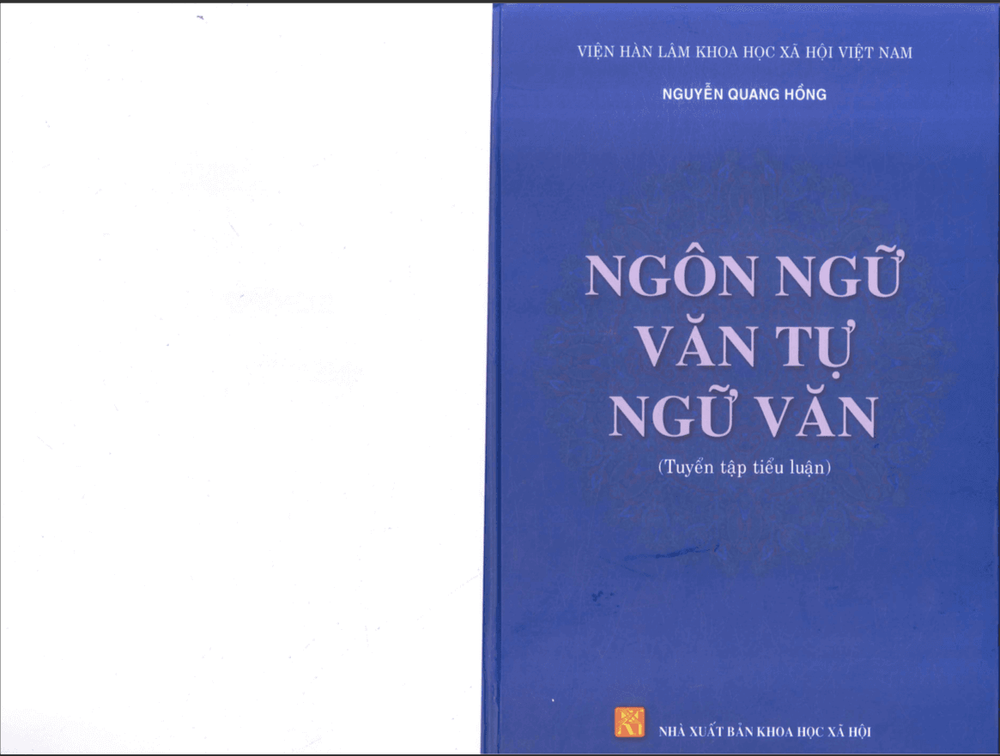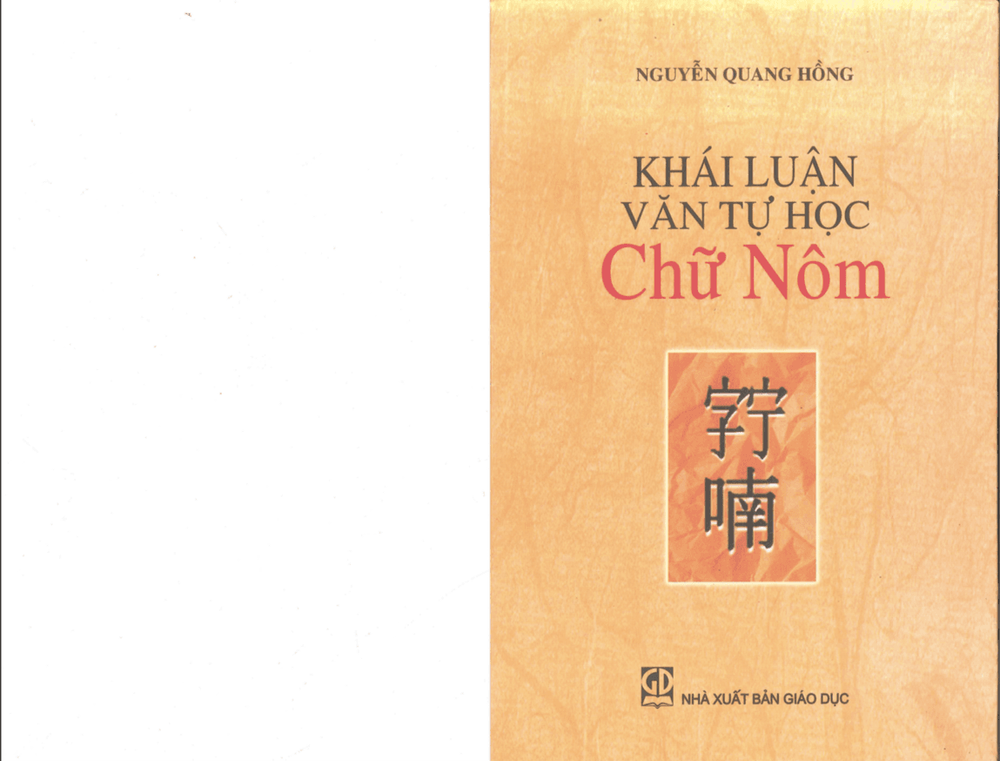






1. The State Award for a Monograph on Nôm Script
On January 11, 2017, the President of the Socialist Republic of Vietnam signed Decision No. 104/QĐ-CTN awarding the Hồ Chí Minh Prize to 9 scientific and technological works, and Decision No. 105/QĐ-CTN awarding the State Prize to 7 scientific and technological works, according to the five-year review regulation. On January 15, 2017, at the Ministry of National Defense Auditorium in Hanoi, the Hồ Chí Minh Prize and State Prize for Science and Technology, Round 5, were presented to outstanding scientists from across the country. President Trần Đại Quang attended the ceremony and presented the awards to the winning scientists. In his speech at the ceremony, the President acknowledged: “The works awarded the Hồ Chí Minh Prize and State Prize for Science and Technology this time are excellent, representative works, effectively applied, and have great significance in protecting health, improving people's living standards, enhancing the competitiveness, position, and scientific and technological level of the country in the region and the world.”
During the ceremony, Mr. Chu Ngọc Anh, Minister of Science and Technology and Chairman of the State Prize Council, stated: “In the field of social sciences and humanities, there are outstanding achievements in the study of philosophy, history, and language, including clarifying the intellectual height of the Vietnamese people as well as the values, limitations, and valuable historical lessons left by our ancestors; there are studies on Nôm script according to a new theoretical framework and new approaches, which have been warmly received by the research community both domestically and internationally. These works are widely used in specialized studies of Nôm script and Hán Nôm literature in Vietnam and abroad today.”
Among the works and authors honored in this round is the monograph Khái luận văn tự học chữ Nôm (An Introduction to chữ Nôm Grammatology) (Education Publishing House, 2008) by Professor Nguyễn Quang Hồng, former Deputy Director of the Institute of Hán Nôm Studies (Institute of Hán Nôm). This recognition at the national level is a well-deserved acknowledgment of a high-level theoretical work on philology by a leading scientist in the field of Hán Nôm and script studies. The Institute of Hán Nôm has had several former staff members awarded the Hồ Chí Minh Prize and the State Prize, but they had worked at the Institute for only a short time before moving to other units, receiving the award as staff members of those units. Therefore, this can be considered the first State Award granted to a scientist who has dedicated most of his career to the Institute of Hán Nôm Studies. In this sense, this prestigious award is an honor for the Institute of Hán Nôm and serves as motivation for its staff to continue contributing to the advancement of science and technology.
2. Professor Nguyễn Quang Hồng: The "Powerful" Scholarly Figure
Although born (1939) and working in Vietnam, Prof. Nguyễn Quang Hồng had the fortunate opportunity to receive long-term training at foreign academic centers right from his student years. He graduated with a Bachelor's degree in Philology from Peking University (1965), earned his Associate Doctorate (now known as PhD) in Philology from Moscow State University and the Soviet Union's Institute of Oriental Studies (1974), and later obtained his Doctor of Science in Philology from Moscow State University (1985). With a solid foundation and the ability to absorb the finest knowledge from these two prestigious Eastern and Western literary scientific centers, he produced unique research works on Hán Nôm literature and linguistics. The overarching feature of his works is their high theoretical quality, logically and systematically developed research problems, and a writing style that is scientifically rigorous, yet often witty and engaging rather than overly rigid.
After many years of researching and teaching language and scripts at various universities and specialized research institutes, he has "unveiled" numerous key works: Văn khắc Hán Nôm Việt Nam (Han-Nôm Inscriptions in Vietnam, Editor, 1992), Âm tiết và loại hình ngôn ngữ (Syllables and Language Types, monograph, 1994, 2001, 2012), Di văn chùa Dâu (The Relics of Dâu Pagoda, Editor, 1996), Truyền kì mạn lục giải âm (An Interpretation of Truyền Kỳ Mạn Lục, Annotated, 2001), Tự điển chữ Nôm (Nôm Dictionary, Editor, 2006), Kho chữ Hán Nôm mã hoá (The Hán Nôm Encoded Collection, Co-editor, 2008), Khái luận văn tự học chữ Nôm (An Introduction to Nôm Philology, monograph, 2008), Tự điển chữ Nôm dẫn giải (Annotated Nôm Dictionary, 2 volumes, 2014, nearly 2,400 pages, a personal work), Âm tiết tiếng Việt và ngôn từ thi ca (Vietnamese Syllables and Poetic Language, written with his wife, Dr. Phan Diễm Phương, currently in press). He is also the author of more than 100 research articles published in specialized journals both domestically and internationally. He has been invited to give lectures and engage in scientific exchanges in the United States, France, Japan, China, Taiwan, Hong Kong, and Singapore.
3. An Introduction to chữ Nôm Grammatology: A "Robust" Scholarly Work
The fundamental and crucial feature of this monograph is its methodological premise, which centers on philology as the core concept. This is the key distinction of the book, as previous monographs on Nôm typically placed historical linguistics of the Vietnamese language above philology when approaching the treasure trove of Nôm script. By restoring the essence of philology to the approach of Nôm research, the book addresses a historical shortcoming in Nôm studies, which often focused too much on early-era texts while neglecting those from the 19th and early 20th centuries.
Based on this methodological premise, the book develops its research systematically and with a strong theoretical foundation. While research on Hán Nôm often remains at a descriptive level, Nguyễn Quang Hồng's work, with its theoretical approach, aims to analyze and explain the events, which is a significant step forward compared to the usual approach, where one might simply think “anyone could know that!” However, synthesizing these scattered and isolated pieces of knowledge into a coherent theoretical system, as the author has done in his works (including this book), is not something just anyone can achieve.
Regarding content, the work systematically and comprehensively investigates the key issues in studying the traditional scripts of the Vietnamese people, with a primary focus on Nôm. The monograph is presented in six chapters and one appendix. The first three chapters introduce the traditional writing systems in Vietnam, explore the origins and development of the Nôm script, and identify its typological characteristics in comparison to Hán and other regional scripts. Chapters four and five delve into the functional and structural aspects of Nôm, tracing their evolution over time. The final chapter examines the social functions and operational environments of Nôm, alongside its role in relation to Hán and Quốc ngữ (the national script) in Vietnamese society, both past and present. Additionally, the appendix introduces the ideas of earlier scholars who aimed to create a Vietnamese script using brushstrokes resembling Nôm but functioning as a phonetic writing system, showcasing a unique aspect of ancient philological thinking.
The book is a significant achievement in research with both breadth and depth, presenting new insights grounded in a thorough accumulation and synthesis of knowledge. As a result, it quickly became a key teaching resource for the fields of Hán Nôm studies and literature in universities, graduate schools, and research institutions.
Therefore, the academic community was not surprised when the book was awarded the State Prize, and some even lamented that the work deserved a higher-level award. Scholars know that the author has long established his intellectual stature and academic influence, and the work has been recognized for its theoretical depth and framework-building capability.
4. Scholarly Companions
The academic community in Vietnam has acknowledged the leading positions of two giants in linguistics: Professor Cao Xuân Hạo (1930–2007) and Professor Nguyễn Tài Cẩn (1926–2011). When these distinguished scholars passed away, numerous commemorative articles were written about them, and two pieces titled Hoài niệm... (Recollections) by Professor Nguyễn Quang Hồng are among the most notable. These writings are both heartfelt and scientific, comprehensive yet detailed, clear and coherent, and appropriately critical in their scientific evaluation.
The success of these two Hoài niệm... articles, in addition to the writer’s solid knowledge and deep emotional connection with his colleagues, I believe, also lies in the shared approach to philological research between the three scholars. They were among the few who early on recognized the shortcomings of the Eurocentric mindset that was once quite prevalent in linguistic studies and research in general in Vietnam. Perhaps this is why, in his seminal work Phonology and Linearity (French edition, 1985), Professor Cao Xuân Hạo praised a 1974 work by Professor Nguyễn Quang Hồng with respectful words, aligning with his shared rejection of the European "segmentalist" approach, which criticized the use of European phonological theories that only applied to inflected languages when analyzing isolating and agglutinative languages of the East, such as Chinese, Vietnamese, and Japanese.
Reading these two Hoài niệm... articles, I found myself agreeing with two terms used by Professor Nguyễn Quang Hồng. He described two monographs on phonology and grammar by Professor Cao Xuân Hạo as "vạm vỡ" (robust), and he evaluated the monographs by Professor Nguyễn Tài Cẩn as "lực lưỡng" (vạm vỡ). Reflecting on this, although all three scholars had small, lean physiques, they were all "powerful" and "robust" in science. That is what is truly difficult to achieve. It seems to me that Professor Nguyễn Quang Hồng's An Introduction to chữ Nôm Grammatology has also reached the "powerful" and "robust" level. Therefore, I would like to borrow these two terms to describe the person who used them so aptly. This State Prize is a confirmation of the value of the book and the stature of the scholar from the perspective of national science and technology management, after it had already been acknowledged by the academic community.
Footnotes:
This article was written by Associate Professor, Dr. Nguyễn Tuấn Cường, Director of the Institute of Hán-Nôm Studies, in 2017, when Professor Nguyễn Quang Hồng was awarded the State Prize in Science and Technology for his work An Introduction to Nôm Philology. The article was published in Hán Nôm Journal, Issue 1 (140), 2017. We are reprinting the article here with the permission of the author, Associate Professor, Dr. Nguyễn Tuấn Cường.
(1). See three book review articles that were published: (1) Nguyễn Tuấn Cường, “Reading An Introduction to Nôm Philology by Professor Nguyễn Quang Hồng,” Hán Nôm Journal, Issue 4/2009, pp. 74-78. (2) Đinh Khắc Thuân, “Reading An Introduction to Nôm Philology,” Language and Life, Issue 5/2009, pp. 44-45. (3) Trần Đình Sử, “A New Contribution to Nôm Studies,” Literature and Arts, Issue 27 (2579), Saturday, 4/9/2009.
(2). See: (1) Nguyễn Quang Hồng, “Recollections of Cao Xuân Hạo,” Language and Life, Issue 11/2007, pp. 38-39 (electronic version: http://ngonngu.net/?m=print&p=354). (2) Nguyễn Quang Hồng, “Recollections of Professor Nguyễn Tài Cẩn,” Lexicography and Encyclopedia, Issue 2/2011, pp. 78-84 (electronic version: [http://khoavanhoc.edu.vn/tintuc sukien/878-gstskh-nguyn-quang-hng](http://khoavanhoc.edu.vn/tintuc sukien/878-gstskh-nguyn-quang-hng)).
(3). Cao Xuân Hạo, Phonology and Linearity: Thoughts on the Postulates of Contemporary Phonology, National University Publishing House, Hanoi, 2001, pp. 303-306.